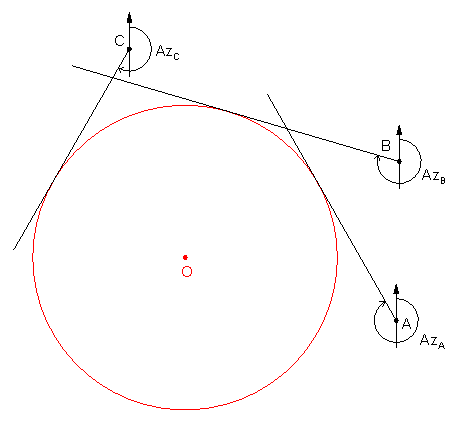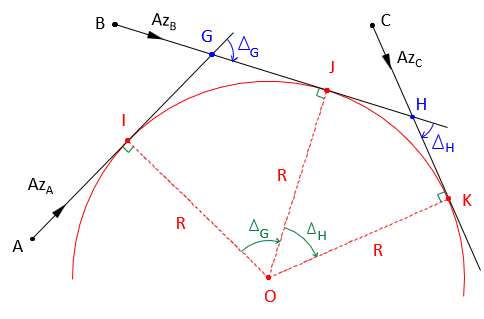C. Three-tangent arc
Three non-colinear intersecting lines can serve as tangent lines to define a circle, Figure I-5.
|
|
|
Figure I-5 |
Figure I-6 shows the primary geometry of the three-tangent arc.
|
|
|
Figure I-6 |
Figure I-7 shows geometry for a curver to the right, as defined by the tangent azimuths.
|
|
|
Figure I-7 |
Points I, J, and K are the tangent points. These divide the curve into two tangent arcs having the same radius with points G and H as their Points of Intersection (PI).
Solution process
Determine PIs, G and H, by direction-direction intersection. Inverse between them to obtain the distance, dGH.
Using the azimuths, compute deflection angles ΔG and ΔH at the PIs.
Compute curve radius using Equation I-19
|
|
Equation I-19 |
R is positive for a curve to the right; negative for a curve to the left.
Distances dGJ and dGI are the tangent distances for the first curve; distances dHK and dHJ are the tangent distances for the second curve. To compute an arc's tangent distance use:
| Equation I-20 |
To compute the coordinates of the radius point
- Forward Computation from point G to point J using AzB and tangent distance dGJ
- Compute azimuth to the radius point, AzJO, by adding (curve to right) or subtracting (curve to left) 90° to/from AzB.
- Forward Computation from point J to point O using AzJO and R.
The coordinates of the radius point can also be computed by Forward Computation sequences:
- Point G to point I to point O
- Point H to point J to point O
- Point H to point K to point O



